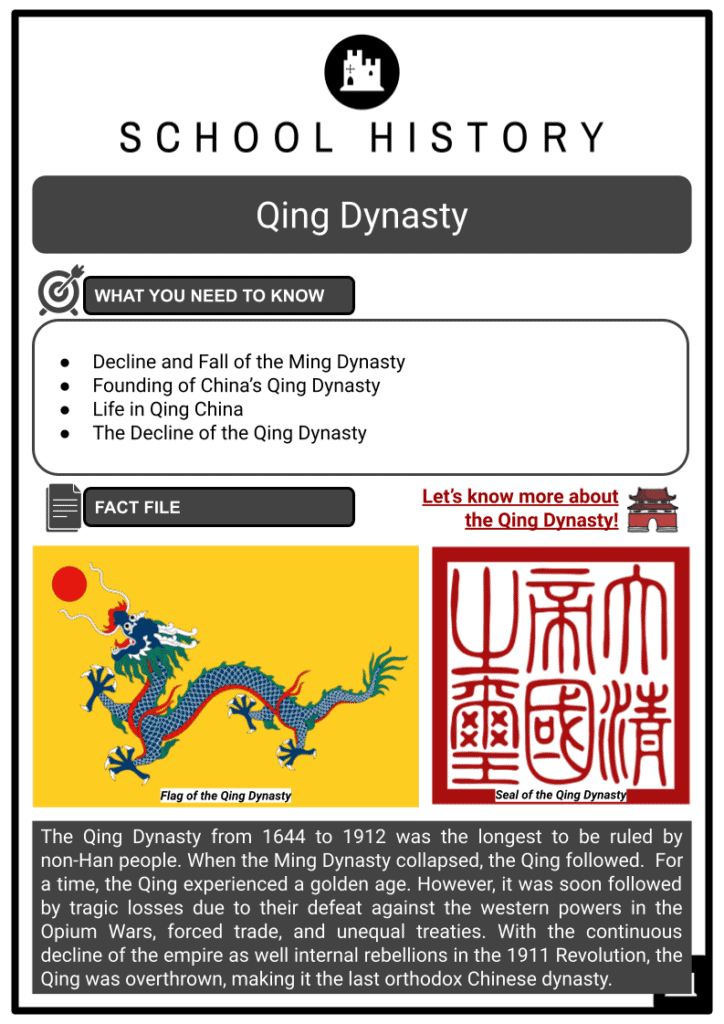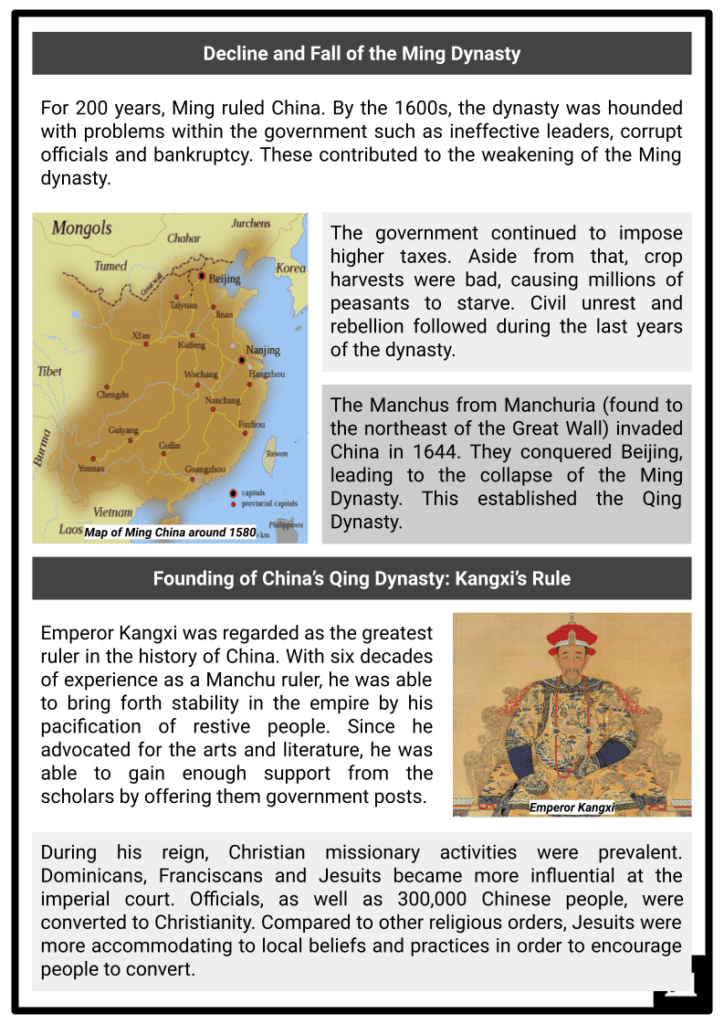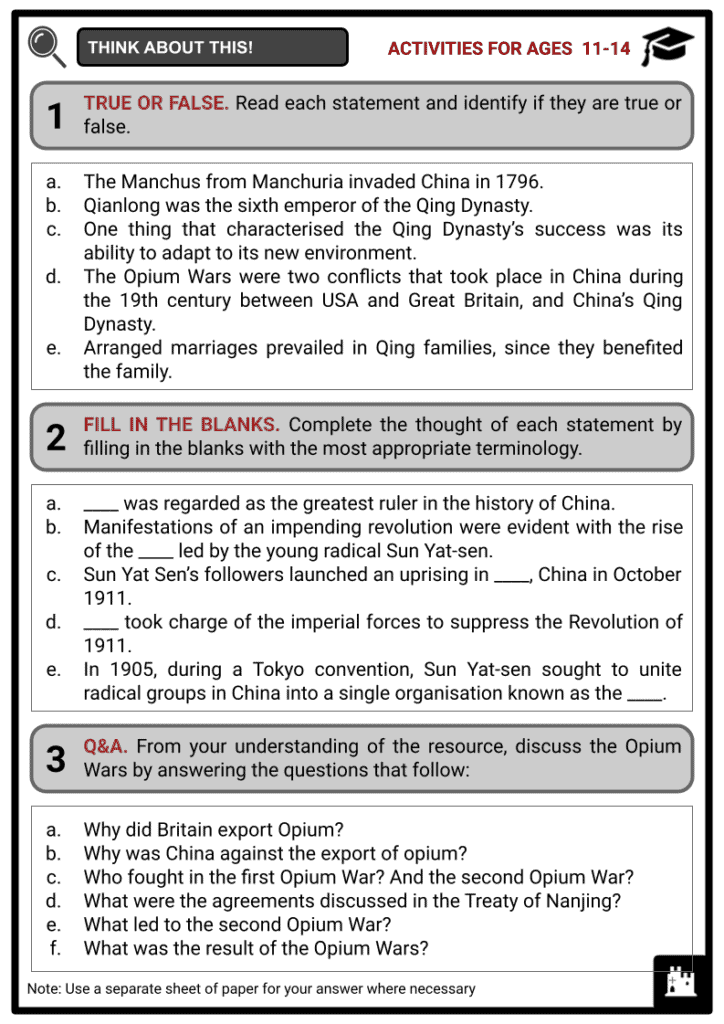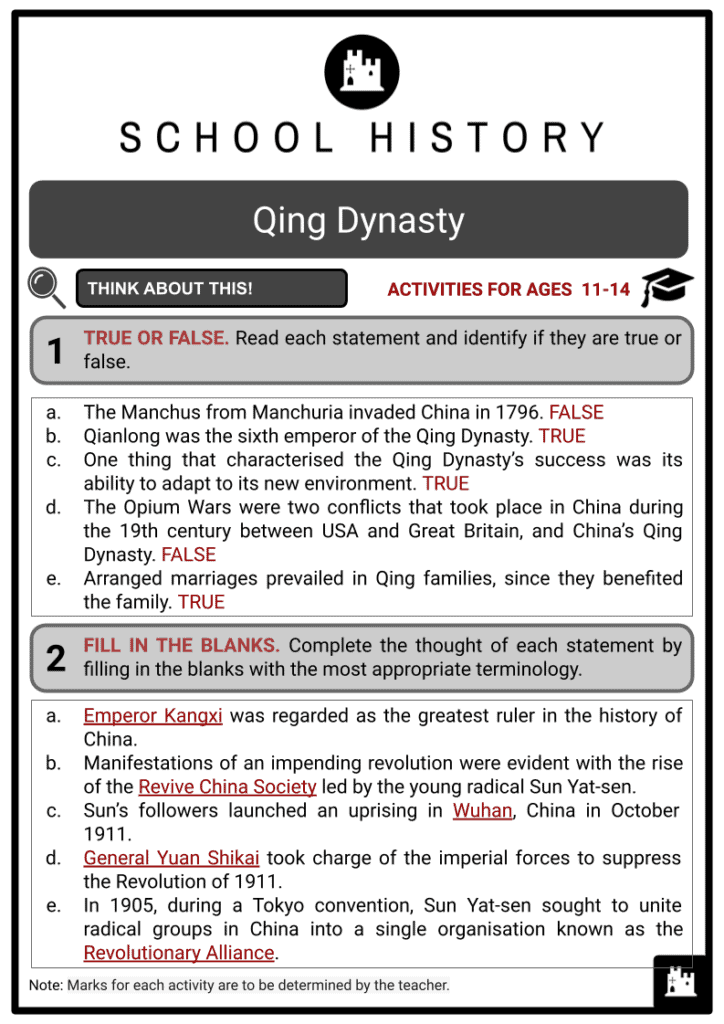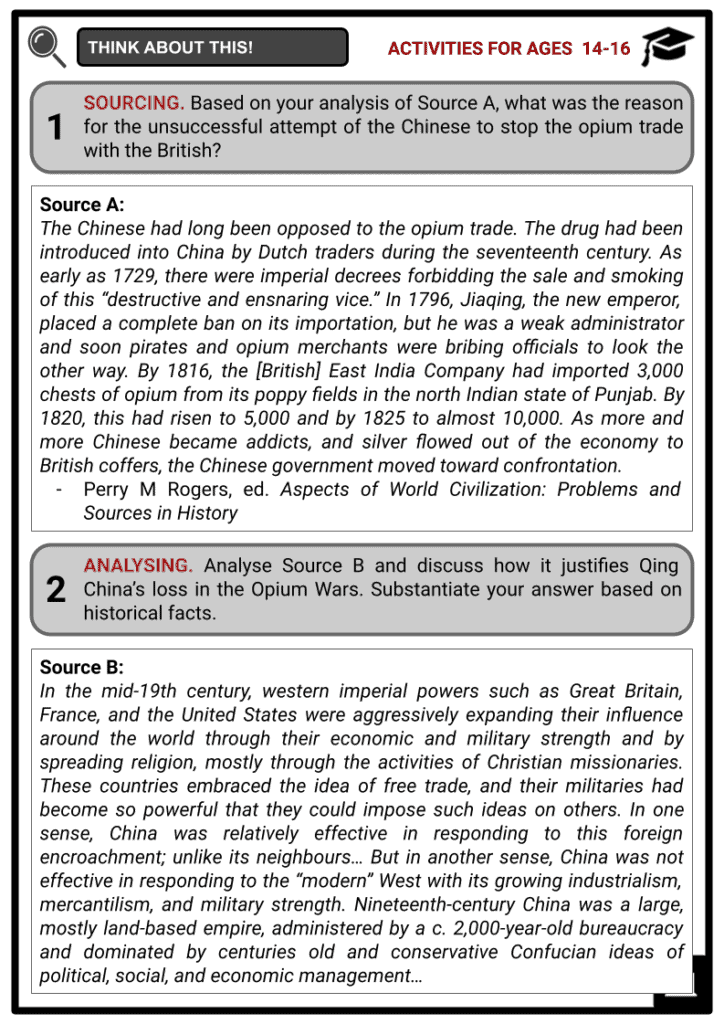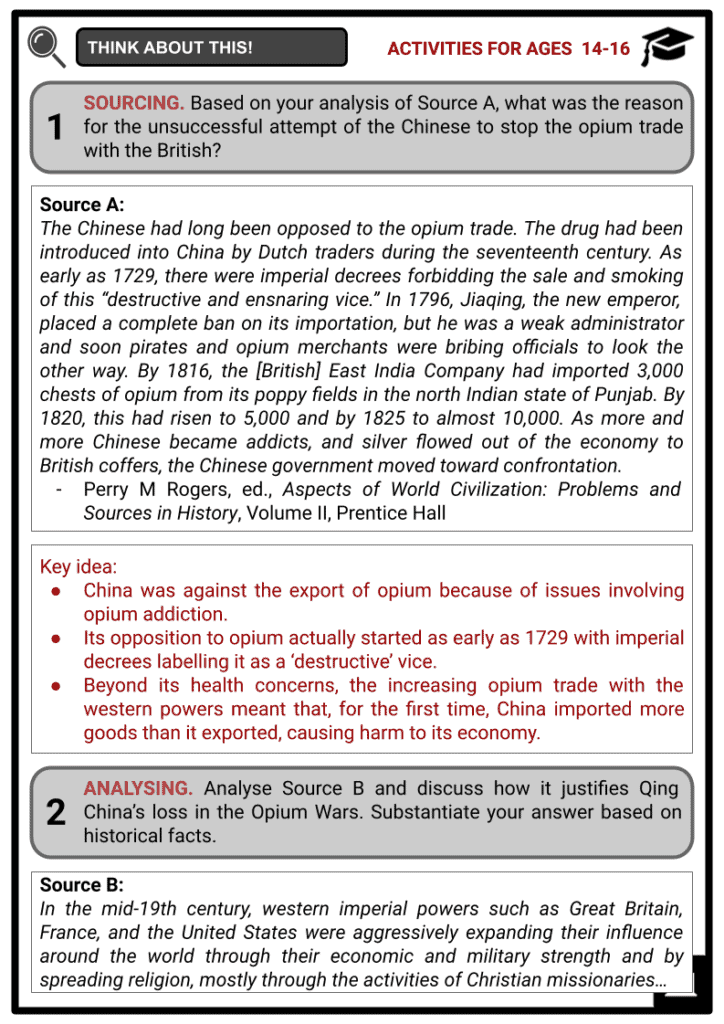Qing Dynasty Worksheets
Do you want to save dozens of hours in time? Get your evenings and weekends back? Be able to teach about the Qing Dynasty to your students?
Our worksheet bundle includes a fact file and printable worksheets and student activities. Perfect for both the classroom and homeschooling!
Summary
- Decline and Fall of the Ming Dynasty
- Founding of China’s Qing Dynasty
- Life in Qing China
- The Decline of the Qing Dynasty
Key Facts And Information
Let’s find out more about the Qing Dynasty!
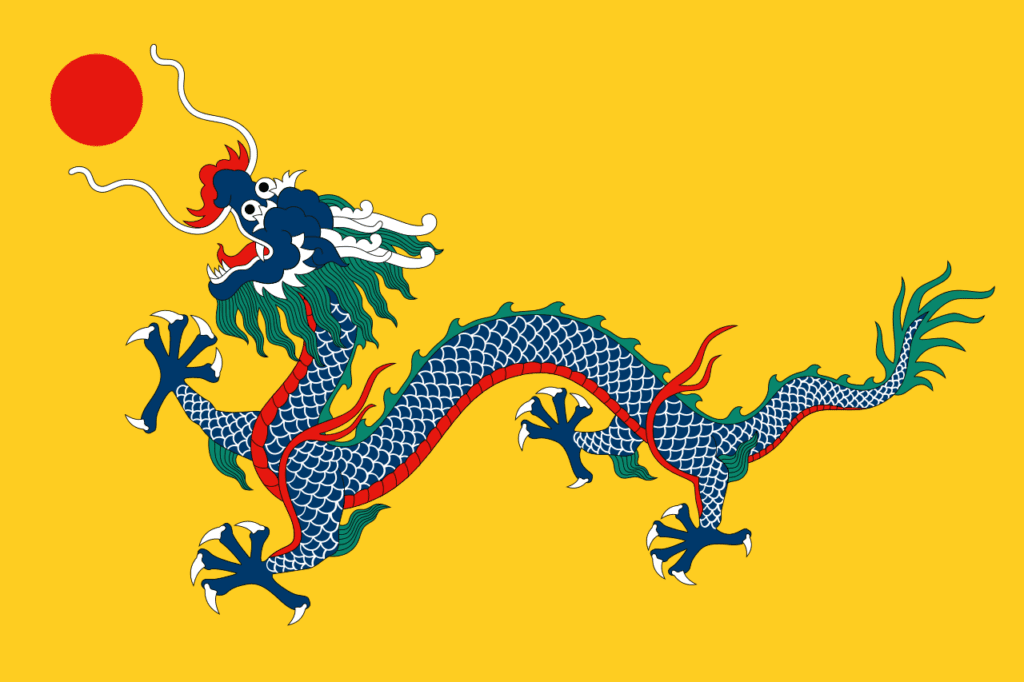
The Qing Dynasty from 1644 to 1912 was the longest to be ruled by non-Han people. When the Ming Dynasty collapsed, the Qing followed. For a time, the Qing experienced a golden age. However, it was soon followed by tragic losses due to their defeat against the western powers in the Opium Wars, forced trade, and unequal treaties. With the continuous decline of the empire as well internal rebellions in the 1911 Revolution, the Qing was overthrown, making it the last orthodox Chinese dynasty.
Decline and Fall of the Ming Dynasty
- For 200 years, Ming ruled China. By the 1600s, the dynasty was hounded with problems within the government such as ineffective leaders, corrupt officials and bankruptcy. These contributed to the weakening of the Ming dynasty.
- The government continued to impose higher taxes. Aside from that, crop harvests were bad, causing millions of peasants to starve. Civil unrest and rebellion followed during the last years of the dynasty.
- The Manchus from Manchuria (found to the northeast of the Great Wall) invaded China in 1644. They conquered Beijing, leading to the collapse of the Ming Dynasty. This established the Qing Dynasty.
Founding of China’s Qing Dynasty:
Kangxi’s Rule
- Emperor Kangxi was regarded as the greatest ruler in the history of China. With six decades of experience as a Manchu ruler, he was able to bring forth stability in the empire by his pacification of restive people. Since he advocated for the arts and literature, he was able to gain enough support from the scholars by offering them government posts.
- During his reign, Christian missionary activities were prevalent. Dominicans, Franciscans and Jesuits became more influential at the imperial court. Officials, as well as 300,000 Chinese people, were converted to Christianity. Compared to other religious orders, Jesuits were more accommodating to local beliefs and practices in order to encourage people to convert.
Qianlong’s Rule
- The Dominicans and Franciscans complained to the Pope about the Jesuits’ actions. This led the Pope to order all missionaries and converts to conform to the official orthodoxy of Europe. Christian activities were suppressed in China after Kangxi’s death.
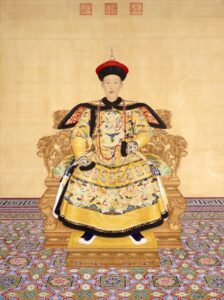
Emperor Qianlong - Qianlong was the sixth emperor of the Qing Dynasty. Prosperity in the Manchu empire continued throughout the 18th century since he was able to reap the benefits from his predecessors. However, initial signs of decay in the empire were observed. Military campaigns were expensive, and corruption became more rampant in the imperial court.
- In the rural areas, civil unrest and rebellion started to become prevalent since higher taxes were imposed, and a rising population created pressure on the land to produce, which made more peasants discontented. They were also forced to settle in infertile lands, which led them to launch the White Lotus Rebellion (1796–1804) that was suppressed suddenly.
Life in Qing China:
Politics
- One thing that characterised the Qing Dynasty’s success was its ability to adapt to the new environment. It retained much of the political structures from the Ming Dynasty, but introduced a few changes. The leaders had devoted themselves to Confucianism to establish their legitimacy as rightful rulers of China.
- Despite this, they were seen as different from the rest of the Chinese population in terms of ethnicity, culture and language. To cope with this, the Qing rulers adopted the following strategies to rule their empire:
- Separation of Manchus from the Chinese population: Manchus were separated from the Chinese. Others were assigned to farmlands and organised into military units known as banners. They composed the empire’s strong military force. Ethnic Chinese were not allowed to settle in Manchuria.
- Imposition of Manchu Practices: The Qing rulers ordered the ethnic Chinese people to wear their hair in a Q. This symbolised their submission to the Qing Dynasty and recognition of their rule.
- Despite the Qing Dynasty’s efforts to preserve their identity as they ruled China in the 17th century, they also recognised the fact that the ethnic Chinese could play an important role in the imperial court. They had to be appointed to top rank positions. This led to the creation of a system known as the dyarchy, where both Chinese and Manchus had an equal share of administrative positions.
Family Life
- Family was an important unit of society in Qing China, since rice cultivation required intensive labour. Large families were needed to help with large rice harvests. Old parents were given a sense of security as their children would be able to continue to work in the rice fields.
- In Qing China, sons were the prized possessions of the family, given their strength and ability to raise their own families in the future. Limited employment opportunities forced them to assist their parents in the rice fields. The oldest male was the king and was obeyed in the family.
- Arranged marriages prevailed in Qing families, since they benefited the family. Usually, the bride and the groom would meet during the wedding day itself, and they were not consulted. Love was seen as a distraction to the couple’s responsibilities in taking care of their growing family.
- Clans were composed of several families within a unit. They were very useful in Qing China. Richer families within the clan could provide support to the poor families in terms of education, or they rented lands to them. When a young man became an official, it brought prestige to the clan he belonged to.
Role of Women
- Traditionally, women were treated as inferior to men in China. This was rooted in their belief that men were the only ones capable of governing others, carrying family rituals, and aspiring to a government career or scholarships. If this was the case, what was the role of women in Qing China?
- ON DIVORCE: Wives could not legally divorce their husbands. But husbands could legally divorce their wives, or marry another wife if their current wife could not bear male heirs.
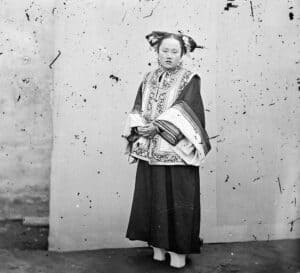
A Manchu woman in 1869 - ON PROPERTY: A wife could not inherit property. When her husband died, his relatives would inherit all the property, including her original dowry.
- ON FEMALE CHILDREN: They were less desirable due to their limited physical strength. Her parents had to pay dowry to her future husband’s parents.
- ON BUDGETING IN THE FAMILY: Women in Qing China were in charge of budgeting the money in the family.
- ON RAISING CHILDREN: Since the wives were left at home, they took the role of educating their children. They were the ‘first teachers’.
- ON EDUCATION AND ARTS: Privileged women were trained in Confucian classics though this was less rigorous. They were able to create great artworks.
The Decline of Qing Dynasty
- The Opium Wars were two conflicts that took place in China during the 19th century between France and Great Britain, and China’s Qing Dynasty. The first Opium War (1839–1842) was fought by China and Britain, while the second Opium War (1856–1860) was fought by China and Britain, alongside France.
- For more than two hundred years, Europeans had established trade relations with China. China’s Qing Dynasty only allowed European merchants to conduct trading activities in a small trading port in Guangzhou. This arrangement was not favourable for the merchants, especially the British. They expressed their opposition to this.
- The British had also complained of unfavourable and imbalanced trade with China. Their imports from China were greater than their exports, since they only sold Indian cotton in China. Since this was not enough to cover the cost of the imported products, Britain was forced into additional pay through silver.
- Britain had attempted to even things out by negotiating a trade balance with China, but it failed. Left with no alternatives, Britain thought of exporting opium, which was sponsored through the British East India Company.
- Opium, which is a highly addictive drug, was grown in northern India and shipped directly to Chinese markets. The tables turned against China since the officials of the British East India Company obtained huge volumes of silver as a result of exporting opium. Demand for the product rapidly increased. The increasing opium trade with the western powers meant that, for the first time, China imported more goods than it exported.
The First Opium War (1839–1842)
- The Chinese government responded to this by appealing to the British government to stop exporting opium. The latter refused to do so. The small trading port in Guangzhou was blockaded by the Chinese government, which forced British traders to surrender chests of opium.
- British warships responded to the blockade by destroying Chinese coastal and river forts. They were almost unopposed when they passed through the Yangtze River going to Nanjing. The Qing Dynasty eventually called for peace negotiations with the British through the Treaty of Nanjing in 1842.
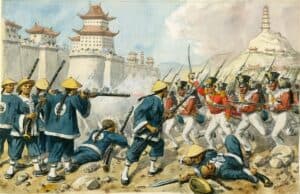
First Opium War - Among the agreements discussed in the Treaty of Nanjing between the British and Chinese governments included the opening of coastal ports to British trade, placing limitations on taxes for imported British goods, and paying for the costs of the war. In addition, China agreed to give the island of Hong Kong to the British. However, nothing was mentioned as to whether the opium trade would continue or not.
- While the Qing Dynasty was trying to suppress the ongoing Taiping Rebellion in the mid-1850s, the British found a way to reignite hostilities with China. The motive for doing this was for the British Empire to expand its trading rights and activities in mainland China.
The Second Opium War (1839–42)
- In October 1856, Chinese officials boarded Arrow, a British-registered ship in Canton (Guangzhou), arrested crew members, and allegedly lowered the British flag. In retaliation, a British warship passed through the Pearl River and attacked Canton. The British and the Chinese troops began exchanging attacks, which disrupted trading activities. The Chinese burned British factories.
- Even though the Chinese presented a different route leading to Beijing, the British and French troops still went through Dagu. In response, the Chinese did not want to resume negotiations to ratify the treaties that were signed in June 1858. This resulted in the resumption of hostilities in China. In August 1860, British and French troops destroyed Dagu batteries.
- Later in October 1860, they were successful in seizing Beijing and in burning Yuanning Garden, the emperor’s summer palace. The war was won by Britain and France. Following the conclusion of the war, the Chinese government signed the Beijing Convention. In the convention, the Chinese agreed to abide by the Tianjin treaties and cede the southern part of the Kowloon Peninsula to Britain.
Attempts at Reform and the Collapse of the Dynasty
- In the duration of its reign, the Qing Dynasty avoided change and limited interactions with the western countries. However with the increasing pressure to adopt the western lifestyle, the empire eventually gave in. Empress Dowager embraced a number of reforms in an attempt to save the dynasty’s reign.
- ON EDUCATION: Instead of the traditional civil service examination, a new educational system based on a western model was adopted.
- ON THE CONSTITUTION: A commission was formed in 1905 to review the Constitution, which led to the establishment of legislative assemblies.
- ON POLITICAL REFORMS: A national assembly election was conducted in 1910, since legislative assemblies were established for each province.
- Expectations were extremely high among the provincial elites, following the dynasty’s attempt to institute reforms to prevent its collapse. However, they did not feel these changes were effective. In addition, local investors were left behind when it came to financing railway development projects. Transportation workers, peasants, artisans and miners were extremely affected by high taxes and bribery from government officials. Unrest in rural areas continued to prevail.
The Rise of Sun Yat-sen
- Manifestations of an impending revolution were evident with the rise of the Revive China Society led by the young radical Sun Yat-sen. He was able to study English, British History, Mathematics, Science and Christianity in Hawaii. He returned to China to practise medicine.
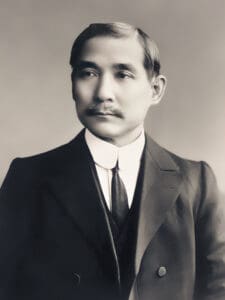
Sun Yat-sen - In 1905, during a Tokyo convention, Sun Yat-sen sought to unite radical groups in China into a single organisation known as the Revolutionary Alliance. It stood by his three people’s principles, namely nationalism, democracy and people’s livelihood.
- Sun believed that China was not ready for democracy. With this, he laid his plans for a new China: (a) driving out the Manchus; (b) restoring China; (c) establishing a new Republic; and (d) equalising land ownership. This earned support from a rising discontented public.
The Revolution of 1911
- Sun’s followers launched an uprising in Wuhan, China in October 1911. However, with Sun’s visit to the US, leadership was lacking. Qing China was on the verge of a collapse with the death of Empress Dowager in 1908 and continuous internal unrest in the empire.
- General Yuan Shikai took charge of the imperial forces to suppress the rebellion. However, he eventually abandoned the Manchus. Sun’s party did not have any military experience or political strength to seize the empire. They were forced to count on Shikai. Shikai agreed to serve as the provisional president of the new Chinese republic after being elected by the revolutionaries.
- The Qing Dynasty eventually collapsed. Provinces in China had gradually declared their independence from the Qing court. The events that happened in 1911 were seen as a revolution that overthrew the collapsing Qing empire, marred with internal problems, rather than an opportunity to build new institutions that would institute genuine reforms in society.
- The advocacies of the Revolutionary Alliance were purely based on liberal democratic ideas of the western countries. They were aimed at the urban middle class in China, but it was too small to form a new political base. Sun’s party failed to capitalise on the discontentment of the public towards the Qing empire. Sun attempted to win the peasants’ support by instituting a land reform programme, but few of them joined the 1911 revolution.
Image Sources
- https://upload.wikimedia.org/wikipedia/commons/thumb/b/b6/Flag_of_China_%281889%E2%80%931912%29.svg/1280px-Flag_of_China_%281889%E2%80%931912%29.svg.png
- https://upload.wikimedia.org/wikipedia/commons/1/16/%E6%B8%85_%E9%83%8E%E4%B8%96%E5%AE%81%E7%BB%98%E3%80%8A%E6%B8%85%E9%AB%98%E5%AE%97%E4%B9%BE%E9%9A%86%E5%B8%9D%E6%9C%9D%E6%9C%8D%E5%83%8F%E3%80%8B.jpg
- https://upload.wikimedia.org/wikipedia/commons/thumb/3/3f/Manchu_woman_by_John_Thomson_Wellcome_L0056491_%28cropped%29.jpg/1024px-Manchu_woman_by_John_Thomson_Wellcome_L0056491_%28cropped%29.jpg
- https://upload.wikimedia.org/wikipedia/commons/thumb/4/41/98th_Foot_at_Chinkiang.jpg/1280px-98th_Foot_at_Chinkiang.jpg
- https://upload.wikimedia.org/wikipedia/commons/5/50/Sun_Yat_Sen_portrait_2_%289to12%29.jpg

